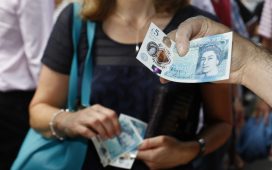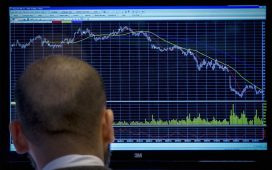
{{0|Pound Sterling}} Extends Declines Against Euro and Dollar After Double Blow Dealt By UK Retail Sales Miss and Consumer Confidence Drop
PoundSterlingLIVE – The can remain under pressure against both the and Dollar after UK retail sales came in at softer levels than expected and an influential barometer plunged, confirming the UK economy continues to slow.
fell 0.9% month-on-month in September said the ONS, which was more than the -0.2% decline the market was positioned for and represents a sharp turn lower from August’s 0.4% expansion.
Retail sales are now down a full per cent on the year to September, which is slightly improved on August’s -1.3% y/y reading but still below expectations for a slight contraction of -0.1%.
The foreign exchange market’s initial reaction was to sell the Pound as investors continue to back a view that the UK economy is set to materially underperform that of the U.S. and (incredibly) the Eurozone:
The data fits a narrative that the Bank of England can afford to keep interest rates unchanged in November, which would, on balance, weigh on the Pound.
“The Bank of England’s higher interest rates are designed to squeeze consumers and keep them from splashing the cash too freely. After September’s higher than expected inflation numbers, weak retail sales may help convince interest rate setters that they can afford to wait before moving rates up again,” says Nicholas Hyett, Investment Manager at Wealth Club.
The Pound to Euro exchange rate is currently 0.86% lower following a week of disappointing UK data releases at 1.1455 and looks set to break lower from its summer range and test levels last seen in May. The Pound to Dollar exchange rate is currently a quarter of a per cent down on the week and is quoted at 1.2112.
The period of elevated inflation is having a material effect on demand in the UK as retail sales volumes have been steadily declining, having peaked in 2021. Yet, UK consumers are forking out more to acquire fewer goods, with the value of retail sales continuing to grow:
Retailers have therefore been protecting their margins by raising prices, but output in the sector is inevitably struggling.
Meanwhile, the GfK consumer confidence survey for October plunged amidst signs that the cost of living crisis and rising interest rates are increasingly being felt, hinting that the economic outlook continues to deteriorate.
“UK consumer confidence has fallen nine points this month to -30 and takes us back to where we were in July this year. This sharp fall underlines that the cost-of-living crisis, and simply not having enough money to make-ends-meet,” says Joe Staton, Client Strategy Director at GfK.
GfK’s long-running Consumer Confidence Index decreased nine points to -30 in October as all five measures were recorded down in comparison to last month’s announcement.
Staton says “fierce headwinds” are facing consumers as they try to meet the costs of heating our homes, filling our petrol tanks, coping with surging mortgage and rental rates and a slowing jobs market.
GfK says the uncertainties posed by conflict in the Middle East are also contributing to this growing unease.
The outlook for retail sales looks to remain poor as GfK’s survey reveals a sharp drop in its major purchase measure, down 14 points.
This, “will concern retailers across the land in the run-up to Christmas,” says Staton.
An original version of this article can be viewed at Pound Sterling Live












